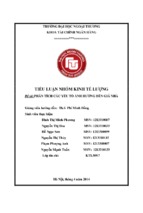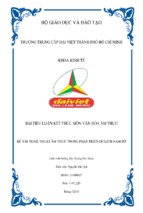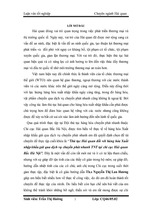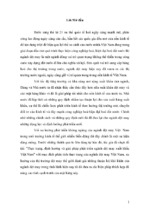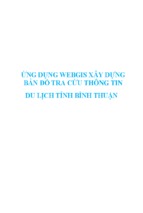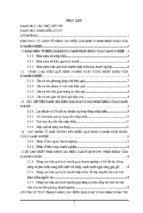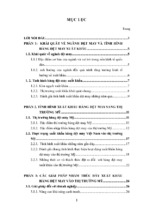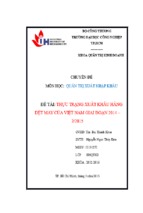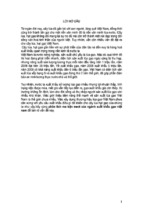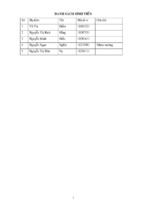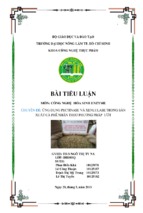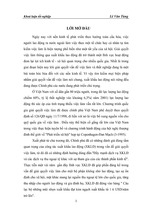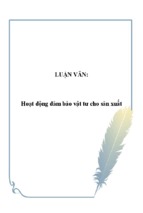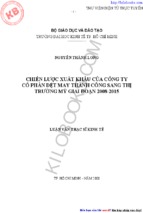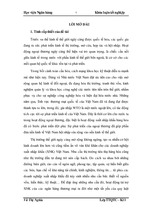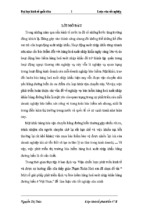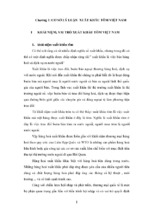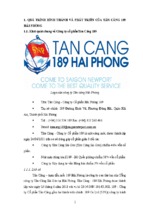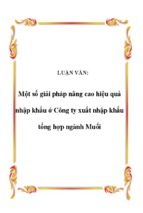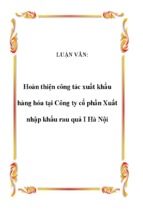ii
ACKNOWLEDGMENTS
First of all, I would like to express my sincere thanks to Dr. Nguyen Minh Ha – my Project
Tutor, for his useful, practical guidance and thorough directions that help me accomplish
my final project.
I am also grateful to Mr. Mulyono Nurlimo – Board of Director, Mayora at Indonesia who
gave me a chance to try Go Choco biscuit and share useful information about the product
as well as company direction.
Secondly, I would like to say thanks to all Professors of MBMM5 program for their
knowledge, experience and enthusiasm during two past years. The knowledge in this
MBMM course make me confident, promoted in my career path.
And finally, last but not least, I want to say thank you for my team at MC advertising – Ms.
Ngoc Yen and Mr. Ngoc Khanh have support me in my current job while I was taking the
sabbatical leave to do this project. And I also owe my closed friends and beloved family
for their support in market research as well as invaluable encouragement.
iii
TUTOR’S COMMENTS
iv
TABLE OF CONTENTS
DECLARATION………..…………………………………………………………………..i
ACKNOWLEDGEMENT………………………………………………………………….ii
TUTOR'S COMMENTS..………………………………………………………………….iii
TABLE OF CONTENTS..…………………………………………………………………iv
ABBREVIATIONS……………………………………………………………………… vii
LIST OF FIGURES AND TABLE……………………………………………………… viii
EXECUTIVE SUMMARY………………………………………………………………...ix
CHAPTER I: INTRODUCTION …………………………………………………………..1
1.1
Problem Statement ....................................................................................................... 1
1.2
Objectives of the Project .............................................................................................. 1
1.3 Scope and limitation of the Project .................................................................................. 2
1.4 Research Method ............................................................................................................. 2
a. Research Design ......................................................................................................... 2
b. Sample Size ................................................................................................................ 2
c. Data Collection ........................................................................................................... 3
1.5
The structure of the Project .......................................................................................... 3
CHAPTER II: LITERATURE REVIEW .............................................................................. 5
2.1 Marketing Plan. ................................................................................................................ 5
2.1.1 Situation Analysis .................................................................................................. 7
a. The situational Environment ................................................................................... 7
b. The competitive Analysis ....................................................................................... 7
c. The internal company environment ........................................................................ 7
2.1.2 Marketing Plan ...................................................................................................... 7
a. Objectives................................................................................................................ 7
v
b. STP Process ............................................................................................................ 8
c. Marketing Mix 5Ps tool .......................................................................................... 8
2.1.3 Implementation and Control .................................................................................. 9
2.2 Digital Marketing ........................................................................................................... 10
2.3 Trade Sales Promotion. .................................................................................................. 10
2.4 Customer behavior ......................................................................................................... 11
CHAPTER III: INTRODUCTION OF THE COMPANY .................................................. 12
3.1
Mayora Company and “Go Choco” biscuit brand ASIA overview .......................... 12
3.1.1
Mayora company in ASIA ............................................................................. 12
a. Mayora company at a glance ................................................................................ 12
b. Mission and Vision in ASIA ................................................................................. 13
c. Products of Mayora Company .............................................................................. 13
3.1.2
Go Choco biscuit in ASIA ............................................................................. 13
3.2 Mayora company and “Go Choco” biscuit in Viet Nam ............................................... 14
3.2.1
Mayora Company in Viet Nam ...................................................................... 14
3.2.2
Go Choco biscuit in Viet Nam ....................................................................... 14
CHAPTER IV: SITUATION ANALYSIS .......................................................................... 16
4.1
Environment ............................................................................................................... 16
4.1.1 Macro economic environmen .............................................................................. 16
a. Social and cultural environment ........................................................................... 16
b. Economic .............................................................................................................. 18
c. Political and Legal background............................................................................. 20
4.1.2 Micro economic environment ............................................................................. 21
a. Market size .......................................................................................................... 21
b. Consumer Insight and Trend 2011 and 2012 ...................................................... 24
4.2
Competitive Analysis ................................................................................................. 27
4.3 Internal Analysis ............................................................................................................ 37
vi
4.4. SWOT analysis……………………………………………………………………….39
CHAPTER V: MARKETING PLAN .................................................................................. 41
5.1
Marketing Strategy ..................................................................................................... 41
5.1.1 Segmentation, Target and Positioning Go Choco ……………………..……….41
a. Segmentation:........................................................................................................ 41
b.Target Audience. .................................................................................................... 41
c. Positioning in Viet Nam’s market ......................................................................... 41
5.1.2 Marketing Mix 5 Ps tool ...................................................................................... 42
5.2 Objectives of the Marketing Plan .................................................................................. 48
5.3 Budget and Detail of Marketing Plan: IMC Plan .......................................................... 48
5.3.1 Budget.................................................................................................................. 48
5.3.2 Detail of Marketing Plan: IMC Plan ................................................................... 49
a. Trade Sales Promotion .......................................................................................... 50
b. Digital Marketing .................................................................................................. 53
c. Sampling or Selling Activation ............................................................................. 55
d. Event and Sponsorship.......................................................................................... 58
e. CRM ...................................................................................................................... 59
5.4
Timeline table ............................................................................................................. 62
CHAPTER VI: CONCLUSION AND SUGGESTION ...................................................... 63
6.1 Conclusion ..................................................................................................................... 63
6.2 Suggestion ...................................................................................................................... 63
REFERENCES .................................................................................................................... 64
APPENDIX .......................................................................................................................... 68
a. Sampling and survey questionnaire ................................................................................. 68
b. Estimation of sales amount and cost for trade sales promotion campaign ...................... 72
vii
ABBREVIATIONS
BMI
Business Monitor International
CRM
Customer Relationship Management
Est.
Estimated
FMCG
Fast Moving Consumer Goods
Forex
Foreign Exchange
GT
General Trade
IBA (GHM)
Internationale Bauaustellung (Fair, Berlin, Germany)
IMC
Integrated Marketing Communication
MSG
Monosodium Glutamate
MT
Modern Trade
OOH
Out of home advertising, like billboard
P/E rate
Relationship between Market Price (P) and Earning per Share (EPS) in
stocks market. P/E= P/EPS
POP
Point of Purchase
PR
Public Relationship
R&D
Research and Development
STP
Segmentation, Targeting and Positioning
TAs
Target Audiences
VND
Viet Nam Dong
Vs.
Versus
viii
LIST OF FIGURES AND TABLE
Figure 2.1: Model of Consumer Behavior…………………………………………………11
Figure 4.1: Confectionary market share in Viet Nam’s market, 2010……………………22
Figure 4.2: Turnover and profit before tax of Bibica YTD 2010…………….……………31
Figure 5.1: Huong Thuy sales and distribution model……………………………...……..47
Figure 5.2: Overview of Go Choco biscuit distribution channel……………………...…..47
Figure 5.3: The IMC plan for Go Choco biscuit………………………………………..…50
Figure 5.4: Buying Go Choco biscuit process when do selling and sampling at GT
channel..……………………………………………………………………………………56
Figure 5.5: Module of Collaboration CRM………………………………………………..60
Table 4.1: Vietnamese population by age 2012 ...………………………………….…….17
Table 4.2: Viet Nam Confectionery Sales 2008 to 2015……………………………….…21
Table 4.3: The source of confectionery and cereal for Viet Nam’s market for the first nine
months in 2011…………………………………………………………………………….24
Table 4.4: Criteria of consumers expect from Nelsen research 2011……………………26
Table 4.5: List of top Viet Nam brands 2009……………………….……………….….…35
Table 5.1: Ingredients of Go Choco biscuit……………………………………….………44
Table 5.2: Margin scheme proposal for Go Choco distributors……..…………………….51
Table 5.3: Trade sales promotion expense for Go Choco biscuit 2012…….……………..53
ix
EXECUTIVE SUMMARY
Since Vietnam has joined APEC and abided by the rules of international trade in the
region, many business opportunities and investment come among the members of the
organization. According to the Ministry of Foreign Affairs of Vietnam, within 10 years
from the date of accession, (1998-2008), the members of APEC account for 75 % FDI, 50
% of development aid (ODA), 73 % of exports and 79 % of Vietnam's imports. The import
and export taxes of confectionery industry reduced significantly by stages, from 50 to 20 %
and just 5 % from 01.01.2012. In addition, Vietnam's market is evaluated as one of the safe
place and has the most potential for investment in the region. Huge population creates a
large market size. The Vietnamese always welcome new products from countries as long
as quality assurance and great taste. Moreover, cheap labor and intellectual staff is hardworking and fast-learning new knowledge.
Company Mayora clearly realize the opportunities for business expansion. April 2011, a
new product, Go Choco biscuit, was launched in India and Thailand. The product is the
enthusiasm of R&D of Mayora and Inbisco, the arm of company in India. Go Choco is the
perfect combination between the components to create the difference compared to other
product lines, for average income segment. Product has succeeded and gained impressive
sales. Following this success, Mayora strongly continues to grow in doing business in
Vietnam’s market.
The project aims to research, evaluate and analyze the Viet Nam’s confectionery industry.
This study has identified where Go Choco brand is in Viet Nam’s market, taken advantage
of all opportunities and strengths and simultaneously found out Mayora and brand’s threats
and weaknesses. All these results were the valuable data and were considered the most
important part to understand thoroughly for the further recommendations on the marketing
plan.
There are many marketing activities to bring Go Choco biscuit to consumers. Which ways
is right direction and shortest to achieve sales target and brand awareness. With SWOT
analysis, this study proposes the most power tools and activities which provide practical
x
and effective in accordance with Go Choco’s positioning and Mayora's budget for the first
year entering Viet Nam's market. Most of them are below the line and directly interaction
to consumers and low cost.
If marketing plan and its activities are properly implemented, Go Choco will be bound to
win Vietnamese wholesalers and consumers’ trust and love. From this first stable stage,
Mayora continues to set up a marketing strategy for company and product in Viet Nam for
the long term.
1
CHAPTER I: INTRODUCTION
1.1 Problem Statement
Viet Nam has joined the APEC and must comply with the conditions in FTA. The import
tax for confectionery industry, as well as those to other commodities, has significantly
decreased. Meanwhile, the Viet Nam confectionery market promise a high profit with near
90 million populations, and so high potential.
Mayora’s mission and vision are continuously build strong brands and distribution
channels in all fields, being socially and environmentally responsible and to expand their
products to ASIA and become a quality manufacturer of food and beverage products that is
trusted by the consumers both domestic and international market.
In about April 2011, one of Mayora branch in India launched a new product, has named Go
Choco sandwich biscuit and this biscuit has succeeded and continuously develop and
increase the market share to Thailand and some neighboring countries. And Viet Nam is
not outside of Mayora’s destination.
Vietnamese consumers have rights to enjoy the taste of confectionery from different
countries, have rights to choose the best one. This is also an opportunity for Viet Nam
employees to approach, learn, share and work with a leading confectionery Group of
Indonesia.
The above mentioned reasons were the basis for the project with theme “Marketing Plan
for Go Choco biscuit” in Viet Nam’s market to take shape.
Through the Project, following questions will be answered:
What are the major internal and external factors that may effect to Mayora Company
and Go Choco biscuit?
How big market size and what does Go Choco biscuit has to face?
From the Marketing Strategy of Mayora, how to build a marketing plan for Go Choco
biscuit to reach the sales target and to build and win the consumer trust at the first year
entering into Viet Nam’s market?
1.2 Objectives of the Project
There are 2 key objectives the Project to research and solve as below:
2
- To research information of Viet Nam biscuit market and analyze the external and
internal factors that affect to Mayora Company and new brand. And based on these factors,
find out the opportunities and threats for brand. After all, re-positioning Go Choco biscuit
in Viet Nam’s market.
- With the above database, through analysis, building marketing plan to get the sales
target in the first year company enter into Viet Nam’s market.
1.3 Scope and limitation of the Project
Scope of the Project: This study only focuses on the Marketing Plan for the first year Go
Choco biscuit entering into Viet Nam’s market. And the primary data about consumer
comments for Go Choco biscuit were done and surveyed for 90 people in HCMC and 30
consumers in Ha Noi only.
Limitation: Through a short meeting with the board of directors of Mayora in Vietnam,
there are some advantages in order to do the project such as having a product sample, a
company direction, an opportunity to learn about the Viet Nam confectionery industry. At
the same time, there are certain limits. Specifically, detailed information about the
company Mayora is just secondary data and stuffed on the internet.
1.4 Research Method
This is exploratory research and writer uses both primary and secondary data.
a. Research Design
The research will employ a survey kind of research design to collect primary data from the
consumers.
b. Sample Size The total 120 samples and questionnaires were directly given to consumers
whose ages range from 12 to 60 years old, class B and C. There are 90 people in HCMC
and 30 people in HN. After trying the Go Choco biscuit, the interviewee gave answers in
the answer sheet. Respond rate is 100%, and the valid rate was 95 % (5 % has given
insufficient information). The respondents were chosen as mentioned because Go Choco
biscuit is for all consumers, but in marketing plan we just focus on the primary TAs:
teenagers and young with age from 13 to 23 years old and moms having kids from 6 to 12
years old, class B and C.
3
c. Data Collection: Both Primary and Secondary data
Primary data has been collected from doing the sampling and get consumer feedbacks
and in-depth interview 4 shop owners at wet market: 1 at old market (Cho Cu, district 1)
and 3 retailers at Ban Co wet market in district 3 in HCMC. The questionnaires consult
about the consumer insight, which factors influence on their selling, some competitors
information.
Secondary data includes information related to Mayora Company, Go Choco biscuit,
confectionery industry in Viet Nam’s market, and all information about competitors of Go
Choco.
1.5 The structure of the Project
The Project has been organized including 5 chapters:
Chapter I: Introduction. This chapter gives an overview about the problem statement,
project objectives, and research method.
Chapter II: Literature Review: provide theories related to Marketing Plan. It includes
definition, structure of Marketing Plan, some kind of promotions and digital marketing,
consumer behaviors.
Chapter III: Introduction about Mayora Company and Go Choco biscuit in ASIA and Viet
Nam. This chapter also gives an overview about the Mayora’s history, vision, mission,
product category. The detail information of Mayora Company and Go Choco biscuit in
ASIA and their business status in the Viet Nam’s market
Chapter IV: Situation Analysis: Chapter III includes analysis of the external and internal
factors influence to Mayora and its product from macro to micro environments as well as
consumer’s insight in confectionery industry. It also indentifies the Go Choco biscuit’s
strengths, opportunities as well as weaknesses and threats in Viet Nam’s market. Besides,
this chapter also researches competitors’ information to know Go Choco is facing which
rivals and which strengths, weaknesses they are.
4
Chapter V: Marketing Plan: From the relevant literature and analysis, this chapter proposes
the Marketing Strategy and Marketing Plan for Go Choco biscuit. And chapter IV gives an
action plan with detailed activities, timeline and budget for each suggestion to execute the
proposed marketing plan.
Chapter VI: Conclusion and Suggestion: After researching the subject, the writer gives
some conclusions, along with solutions and recommendations proposed about the brand
and confectionery industry in Viet Nam.
5
CHAPTER II: LITERATURE REVIEW
The literature review serves as the fundamental for the Marketing Plan in the following
chapters.
2.1 Marketing Plan.
A simple and meaningful definition of Susan Ward (2011) about Marketing “Marketing is
all about letting people know about the product or service we offer, and persuading them to
buy or use it. And for effective marketing we have to let people know about our product or
service repeatedly”.
To do this, we're going to have to come up with both a marketing strategy and a marketing
plan. So what's the difference between a marketing strategy and a marketing plan?
Laura Lake (2011) quoted the marketing strategy is shaped by overall business goals. It
includes a definition of our business, a description of our products or services, a profile of
our target users or clients, and defines our company's role in relationship to the
competition. The marketing strategy is essentially a document that we use to judge the
appropriateness and effectiveness of our specific marketing plan.
To put it another way, marketing strategy is a summary of company's products and position
in relation to the competition; our sales and marketing plan are the specific actions we're
going to undertake to achieve the goals of the marketing strategy.
The marketing plan, then, can be thought of as the practical application of the marketing
strategy. The marketing plan includes details about our business' unique selling
proposition, pricing strategy, the sales and distribution plan and our plans for advertising
and promotions.
So in effect, we can't have a marketing plan without a marketing strategy. But a marketing
plan without a marketing strategy is a waste of time. The marketing strategy provides the
goals for marketing plans. It tells you where you want to go from here. The marketing plan
is the specific roadmap that's going to get you there.
6
A successful formula that can be used to further explain the importance on marketing
strategy and marketing planning looks like this:
Marketing Strategy ---> Marketing Plan ---> Implementation = Success
The marketing strategy consists of the "what" has to be done. It informs consumers about
the product or service being offered, inform consumers of differentiation factors.
The marketing plan consists of the "how" to do it. Construct marketing campaigns and
promotions that will achieve the "what" in our strategy.
Olivier Kupferman (2011), in the course “Business and Marketing Plan” cited that
Marketing planning is not filling in a to-do list and a calendar. Marketing planning is
not financial budgeting. Marketing planning is the process of defining the marketing
objectives and strategy, defining the underlying actions to reach the objective and
translating it into a common communication tool.
And when do you do the Marketing Plan? There are 3 marketing planning moments: new
business, innovation and recurrent planning.
In this Project, we do the marketing plan for new business. It is as a part of a business plan,
the marketing plan translates business strategy into marketing strategy (eg. branding,
customer targeting) and into plan (eg. promotion). And the mission is developing the
marketing plan to put the marketing strategy into action.
Source: Olivier Kupferman (2011)
According to William A. Cohen (2001), the Content of Marketing Plan are including:
7
2.1.1 Situation Analysis
The Situation Analysis focused on market definition and the current capability of the
company to serve the market.
a. The situational Environment
This includes macro and micro environment which affect to company and product. The
macro environments are social and cultural environment, economic and technological
level, political and legal background. Micro environments are market size, consumer
insight and market trend. How, when, where, what and why do consumers buy product?
b. The competitive Analysis
Describe company’s main competitors, their products, plans, experience, know-how,
financial, human, and capital resources, suppliers, and their strategy. What marketing
channel do the competitors apply? What are their strengths and weaknesses?
c. The internal company environment
This section evaluates company’s product, experience, know-how, financial, human, and
capital resources, suppliers. What are company’s strengths and weaknesses?
Strengths, Weaknesses, Opportunities, and Threats (SWOT) analysis
Market trends must be considered as the company develops its marketing strategies.
Strengths are internal capabilities that can help the company reach its objectives
Weaknesses are internal elements that may interfere with the company’s ability to achieve
its objectives.
Opportunities are areas of buyer need or potential interest in which the company might
perform profitably.
Threats are challenges posed by an unfavorable trend or development that could lead to
lower sales and profits.
2.1.2 Marketing Plan
a. Objectives
The Marketing and financial objectives should be defined in specific terms so management
can measure progress and take corrective action to stay on track.
8
b. STP Process
Sara Higley (2011) quoted STP marketing, also called strategic marketing, involves
finding a correct segment in which to market your product, identifying the proper target
market and positioning the product to create maximum profits. The most important part of
STP marketing is determining exactly what benefits your product offers and who will
benefit most from using it.
Segmentation
Markets can be broken down into separated segments, each made up of customers with
similar wants, needs and buying habits. It's important for marketing managers to identify
which segment their products will fit best in. Segments can also be broken down into
geographic locations. Once the segment is identified, a marketing plan should be created to
meet its needs.
Targeting
Once a segment is identified, the next step in the STP process is to target the market. You
need to identify the consumers you want to market your product to and determine the
growth potential of the product in the market you choose to target. Once this is determined
you need to use your marketing plan to grab a major part of the market share.
Positioning
When positioning a product, it's important to understand and identify the four p's of the
marketing mix: product, price, place and promotion. You need to make sure you're putting
the right product in the correct place, pricing it competitively, and promoting it to the right
segment. Remember that place can involve both geographic locations and finding the right
placement on store shelves.
c. Marketing Mix 5Ps tool
The marketing mix describes the way you use the primary marketing tools to achieve your
company's objectives. Dave Dolak (2011) cited that marketing plan should address the 5
P's of Marketing: People, Price, Product, Promotion, and Place. If we do not start by
keeping people foremost in mind we are bound to fail. After all, when we talk about
markets we are really talking about people and when we create marketing plans we are
9
designing ways to effectively communicate with people. For FMCG industry, the 5 P's are
in an intentional, tactical way to meet the needs of consumers.
1. Product: The product is the actual goods or services offered by the company and how it
meets the end-user's needs and wants
2. People: How do people affect the perceived value of the product? People that influence
that value can include employees, management, and consumers.
3. Pricing: This includes policies, action program to set initial price and discount price for
wholesalers, retailers and end consumers
4. Place (distribution): the channel by which product is sold (e.g. online, direct mail,
retail); which segment: kids, teenagers, moms…
5. Promotion: This includes advertising, trade sales promotion, publicity, and personal
selling
Communications Strategy
Thus far your plan has talked about what you need to do. Now your plan must discuss how
you will do it. This section will also discuss how you plan to reach and communicate with
each of your market segments and how you will treat each differently. Discuss how you
will position your company based upon your Unique Selling Proposition. Your Unique
Selling Proposition is what you do that is different than anyone else and the single most
important reason you are different than any other company. Your Unique Selling
Proposition is how you will differentiate yourself from your competition.
These above mentioned programs should be specific and measurable with a name, a
responsible person and checked period, and a budget. The marketing plan should be
coordinated with the company’s resources and activities of other divisions that contribute
to the creation, delivery and communication of the product.
2.1.3 Implementation and Control
Taking action to achieve items identified in marketing strategy and marketing plan.
10
Marketing budget and sales forecast to plan for expenditures, scheduling, result for each
activities will be calculated. This control helps management to measure results and identify
problems to adapt and have the better performances.
2.2 Digital Marketing
Digital marketing is the use of digital sources based on electronic signal like Internet,
digital display advertising and other digital media such as television, radio, and mobile
phones in the promotion of brands and products to consumers. Digital marketing may
cover the more traditional marketing areas such as direct marketing by providing the same
method of communicating with an audience but in a digital fashion.
Two different forms of digital marketing exist.
Pull digital marketing in which the consumer must actively seek the marketing content,
often via web searches, and push digital marketing where the marketer sends the content to
the consumer, as in email. Websites, blogs and streaming media (audio and video) are
examples of pull digital marketing. These users have to link to the website to view the
content.
2.3 Trade Sales Promotion.
According to Dave Dolak (2011), Sales promotions are short-term incentives to encourage
the purchase or sale of a product. Media and non-media marketing communication are
employed for a pre-determined, limited time to increase consumer demand, stimulate
market demand or improve product availability. Examples include contests, coupons,
freebies, loss leaders, point of purchase displays, premiums, prizes, product samples, and
rebates.
Sales promotions can be directed at either customer, sales staff, or distribution channel
members (such as retailers). Sales promotions targeted at the consumer are called
consumer sales promotions. Sales promotions targeted at retailers and wholesale are
called trade sales promotions.
Sales promotion includes several communications activities that attempt to provide added
value or incentives to consumers, wholesalers, retailers, or other organizational customers
11
to stimulate immediate sales. These efforts can attempt to stimulate product interest, trial,
or purchase. Examples of devices used in sales promotion include coupons, samples,
premiums, point-of-purchase (POP) displays, contests, rebates, and sweepstakes, trade
allowances, dealer loader, trade contest, point of purchase displays, training program.
2.4 Customer behavior
Customer behavior is the study of how individuals, groups select, buy, use and dispose of
goods to satisfy their needs and wants. Besides the marketing and other stimulus,
consumers’ psychology and characteristics are the key elements for consumers make
decision whether buying the product or not. Studying this provides clues for improving or
introducing
products
and
services,
setting
prices,
devising
channels,
communication messages, and developing other marketing activities.
Figure 2.1: Model of Consumer Behavior
Source: Philip Kotler (2006)
Research into all these factors can provide marketers with clues to reach and serve
consumer more effectively.
crafting
- Xem thêm -


